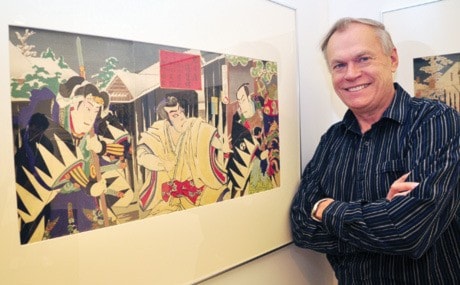A venerated, blood-soaked 300-year-old tale of revenge and loyalty that still resonates through Japan today, is being played out on the walls of the Art Gallery of Greater Victoria.
The gallery has launched Virtuous Vendetta: The story of the 47 Ronin in Prints, a collection of 69 meticulous woodblock images produced by Japan’s finest artists in the 1700 and 1800s. The individual scenes follow the oft-repeated true story of the 47 ronin, while demonstrating the striking detail in what 150 years ago was considered disposable, mass produced art.
“It is a tragedy. Like the Greeks, the Japanese like their tragic stories,” said Barry Till, curator of Asian art for the AGGV for 31 years. Till pulled the collection together over the past several decades. “The story has become the ultimate symbol of the spirit of loyalty to one’s master, no matter what.”
The story unfolds in 1701, with feudal lords Asano Naganori and the elder Kira Yoshinaka, a greedy man who demanded large bribes for advice on official etiquette. Enraged, Asano drew his sword and nicked Kira in the forehead, although unsheathing his weapon within the shogun’s grounds was a serious offence.
On the shogun’s order, Asano committed seppuku – ritual suicide – setting in motion a plot for revenge by Asano’s samurai warriors against Lord Kira. Forty-six masterless samurai called ronin (the 47th is rumoured to be a warrior who wasn’t quite a samurai) bided their time before launching an attack. The lead ronin Ôishi Kuranosuke even made himself appear as a drunk and a womanizer to lull Kira’s men into complacency.
“After a year-and-a-half they assaulted Kira’s mansion. They killed many bodyguards, found Kira and presented him with the sword of their master to commit suicide. Kira refused so they cut off his head,” Till said moving from print to print.
Villagers hailed the ronin as heroes as they travelled to Tokyo to present Kira’s head to their master’s grave. “These samurai showed the ultimate loyalty,” Till said, “and they knew because of it, they had to kill themselves.”
Again on the shogun’s orders and without question, the 46 committed seppuku. Within weeks of their deaths in 1703, people began telling the story of revenge of the ronin through kabuki theater. Millions of ornate woodblock prints soon followed as the story struck a chord with Japanese society and gained widespread popularity.
“The prints are art of the masses, often posted in houses until they fell apart and were thrown out,” said Till, who wrote a book on the prints of the 47 ronin. “Some prints were put into storage. Often you find ones that are 150 to 200 years old in pristine condition. New ones are found all the time.”
Till collected approximately 25 new ronin prints over the past two years through online auctions. Recently depressed prices also brought many Japanese woodblock prints out of the woodwork.
Auctioned prints can fetch up to $400, but $150 is an average price. “Ten years ago it would have been double or triple. It’s a good time to buy,” Till said.
The prints add to the 4000-plus pieces of Japanese art owned by the AGGV. “We have arguably the best collection of Japanese art in Canada – samurai suits, ceramics, paintings,” he said.
Till had planned the exhibition to coincide with the release of the movie 47 Ronin which stars Keanu Reeves, although that film’s release date is now December 2013.
“The scenes are so expressive. The outfits are so strong and powerful,” Till said. “I wanted to show how popular the story is in Japan.”
Virtuous Vendetta prints are on display at AGGV until March 31, 2013. Barry Till is offering a curator’s tour on Jan. 16, 2013 at 11 a.m. and 2 p.m. See aggv.ca for more.



